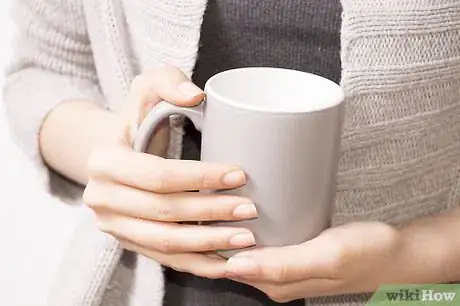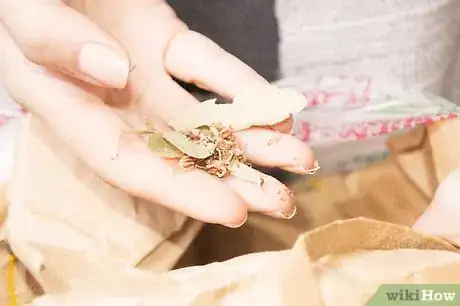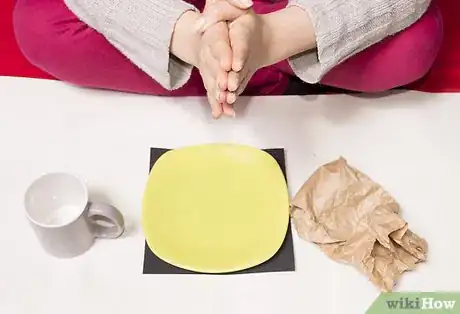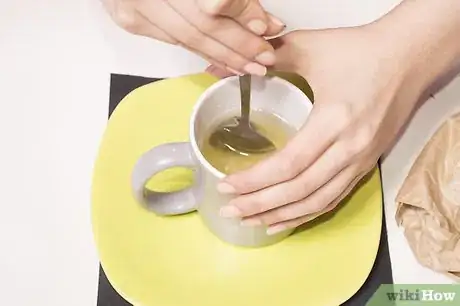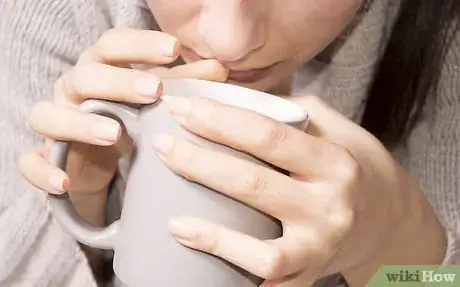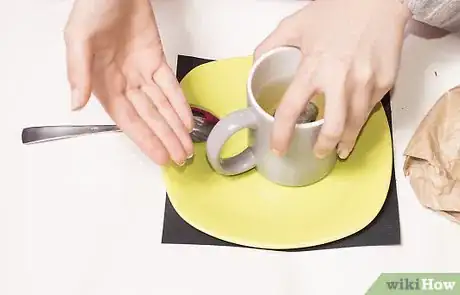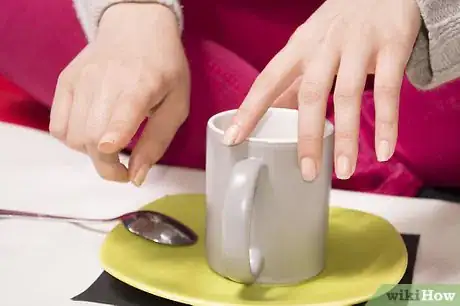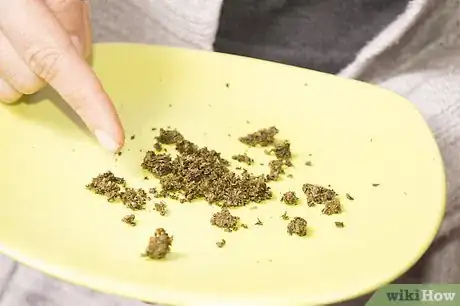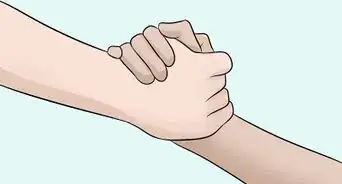wikiHow is a “wiki,” similar to Wikipedia, which means that many of our articles are co-written by multiple authors. To create this article, 14 people, some anonymous, worked to edit and improve it over time.
There are 10 references cited in this article, which can be found at the bottom of the page.
This article has been viewed 145,693 times.
Learn more...
Tasseography is a grand name for the enjoyable art of tea leaf reading. It is performed by interpreting symbols formed by loose-leaf tea on the sides of a cup. It can also be done using coffee grounds from French pressed or Turkish style coffee. [1] [2] Although most people use teabags nowadays to make tea, this change of preference need not deter you from practicing what is perhaps the most "cozy" and domestic of all the methods of divination.
In common with many divination methods, the origins of tasseography ("tasse" is the French word for cup) seem to have been Chinese, having developed the Chinese method of divination based on reading and interpreting the appearance of the insides of bells. When they were turned over, the handle-less Chinese teacups not only resembled bells but were also more easily transported.
This article provides the basics to help you begin reading the tea leaves. Be aware from the outset that the slant you place on interpreting the leaves will very much depend on your spiritual background, divining traditions and psychic intuition.[3]
Steps
-
1Select an appropriate teacup. The following aspects of the cup are important:[4]
- The teacup should be wide, shallow and have sloping sides.
- It should be white or pale on the interior. Cups with patterning on the inside are not suitable for reading tea leaves.
- Use cups, not mugs or narrow cups -- the latter make it hard to see.
-
2Select the appropriate tea leaves. Fine leaf tea leaves are the best; larger leaves are all right but might be harder to read. If you prefer a certain scent over another, that might also have a bearing on your enjoyment of reading tea leaves. In addition, some scents might connote different spiritual meanings for you.[5]Advertisement
-
3Prepare the area. It is important that the reading take place in a comfortable and quiet space. The way in which you make it comfortable is entirely up to you but it is important to remove distractions and to improve the ambiance:
- Turn off electronic media such as the TV, cell phones, take the phone off the hook, computers, etc.
- Use a small table or coffee table to sit around. Add a pretty tablecloth to enhance the appearance.
- Helen Farley recommends saying a prayer for protection, especially when reading for strangers, to ward off any bad energy.[6]
-
4Make the tea. Obviously, the tea must be made using loose tea leaves. Do not strain the tea when pouring from a teapot; if making straight in the cup, simply add the leaves direct to the cup and pour the hot water over the top.
-
5Serve the tea as usual. The person who is asking the question needs to drink the tea and it is that teacup which will be read from. Ask the person to drink until there is about a teaspoon of liquid left in the cup.
- For people who don't like tea, simply drop a teaspoon or so of tea leaves into a cup they have chosen with a teaspoon of liquid.
-
6Ask the cup holder to prepare the tea leaves. There is a deliberate ritual involved here, in order to make the most of the reading:[7]
- Ask the person to think of the most prominent questions.
- Have the person swish the cup to the left three times, holding it in their left hand.[8]
- Ask them to turn the cup upside down on the saucer, gently. This will allow the liquid to drain out.
- Still with the left hand, have the person turn the cup three times to the left while upside down on the saucer.
- Have them hold their hands on the cup in that position, think about the important questions again for a count of seven.
-
7Turn the cup over so that the handle faces the person seeking the answers.
-
8Understand the time line and placement of the tea leaves within the cup.[9]
- Zones from top to bottom may represent either "distance" or "weight" of the omens. Images near the top (rim) are close while images near the bottom are distant. In terms of time, the distance from rim to base represents approximately 6 months. However, "distance" may also refer to relationship to a person or goal. The other way of looking at it is that images at the base of the cup can represent a "heavy" (ill) omen and, as they come nearer the rim, are "light" or joyful omens. The context will determine which is applicable. Context and symbolism are most important. Trust your instincts.
- The handle of the cup is known as the "domain" and images near the handle are images related to home life and family. The further from the handle an image is the more "outside" the omen. Symbols opposite the handle relate to work or strangers, somewhere in between might relate to non-immediate family or "a friend of a friend." Images to the RIGHT of the handle indicate something coming TO the querent while images to the LEFT of the handle represent things coming FROM the domain.
- A big clump of tea leaves with no discernible image might augur trouble on its way. If it is opposite to the handle, the trouble will likely be not of your making but if it is under the handle, it is considered to be of your making.
- If there remains a drop or two of liquid tea that didn't come off with the draining, these are considered to be tears. It might indicate past or future sadness, dependent on the context of the rest of the reading.
-
9Read the tea leaves. To do this, you will need to refer to the meanings of the symbols (images) found in the tea leaves. Once you understand these basics and, after practising the technique often, you will soon become adept at reading the leaves, even for images not set out in this article.
- The most common images and their meanings can be found in this wikiHow list: wikiHow:Tea Leaf Symbols List.
Community Q&A
-
QuestionWhat does a tea leaves representation of a woman praying mean?
 Community AnswerA praying woman is penitent and repentant. She is showing a desire to be humble, to seek forgiveness or guidance and to resolve a problem. This could be signifying that you are aiming to resolve a problem with the guidance of a superior power and/or someone you trust greatly. It is likely reminding you that this is appropriate but that you must be humble in your request. It can also be a sign that you need to trust the guidance of your guardian angel.
Community AnswerA praying woman is penitent and repentant. She is showing a desire to be humble, to seek forgiveness or guidance and to resolve a problem. This could be signifying that you are aiming to resolve a problem with the guidance of a superior power and/or someone you trust greatly. It is likely reminding you that this is appropriate but that you must be humble in your request. It can also be a sign that you need to trust the guidance of your guardian angel. -
QuestionWhat does it mean if I see a phoenix flying up from the bottom side of the cup?
 Community AnswerWhen you see a phoenix like that, it means that you will overcome great suffering and be spiritually reborn.
Community AnswerWhen you see a phoenix like that, it means that you will overcome great suffering and be spiritually reborn. -
QuestionWhat if I see a polar bear and cubs?
 Community AnswerThis could be a signal that you are highly attuned to the environmental problems facing the world and that you are a warrior spirit in need of awakening. It could be telling you to give voice to the quiet activist within, to help mother Earth in the way you know that you want to but that you have been scared to unleash thus far. The fact that it is a polar bear is also suggestive of a journey ahead of you, be it spiritual or actual, a sign that you are nearing a time of great change in how you interact with the world, by beginning to show your true self.
Community AnswerThis could be a signal that you are highly attuned to the environmental problems facing the world and that you are a warrior spirit in need of awakening. It could be telling you to give voice to the quiet activist within, to help mother Earth in the way you know that you want to but that you have been scared to unleash thus far. The fact that it is a polar bear is also suggestive of a journey ahead of you, be it spiritual or actual, a sign that you are nearing a time of great change in how you interact with the world, by beginning to show your true self.
Warnings
- If your reading turns out bad, don't worry, remember to take everything with a pinch of salt. You're the one in charge of your destiny by making sound and sensible choices using your intellect and experience. On the whole, this is meant to be fun.⧼thumbs_response⧽
- Do not use a strainer!⧼thumbs_response⧽
Things You'll Need
- Loose tea leaves (coffee grains can be substituted, see above)
- Teacup
- Kettle
- Saucer
- Teapot/coffee jug
References
- ↑ Wikipedia, Tasseography, http://en.wikipedia.org/wiki/Tasseography
- ↑ Other terms include tassology, tasseomancy, kypomancy, and teacup reading.
- ↑ Occultopedia, Tasseography, http://www.occultopedia.com/t/tasseography.htm
- ↑ Helen Farley, The Complete Guide to Tea Leaf Reading, p. 3 (2000), ISBN 0-7344-0163-9
- ↑ Helen Farley, The Complete Guide to Tea Leaf Reading, p. 4 (2000), ISBN 0-7344-0163-9
- ↑ Helen Farley, The Complete Guide to Tea Leaf Reading, pp. 16-17 (2000), ISBN 0-7344-0163-9
- ↑ Helen Farley, The Complete Guide to Tea Leaf Reading, p. 18 (2000), ISBN 0-7344-0163-9
- ↑ The reason for using the left hand is that this hand is connected to your psychic self.
- ↑ Helen Farley, The Complete Guide to Tea Leaf Reading, pp. 30-31 (2000), ISBN 0-7344-0163-9
- ↑ Margaret Wallauer, ineedcoffee, Coffee Tasseography - Fortune Telling with Coffee, http://www.ineedcoffee.com/01/fortune/
